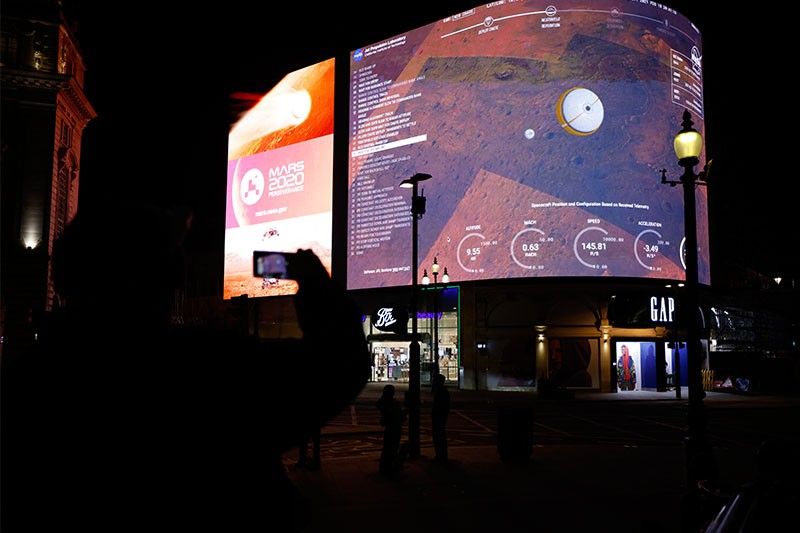Touchdown: NASA's Perseverance rover ready to search for life on Mars

WASHINGTON, United States — After seven months in space, NASA's Perseverance rover survived a nail-biting landing phase to touch down gently on the surface of Mars on Thursday, ready to embark on its mission to search for the signs of ancient microbial life.
"Touchdown confirmed," said operations lead Swati Mohan at around 3:55 pm Eastern Time (2055 GMT), as mission control at NASA's Jet Propulsion Laboratory in Pasadena erupted in cheers.
The autonomously guided procedure was completed more than 11 minutes earlier, which is how long it takes for radio signals to return to Earth.
"WOW!!" tweeted NASA Associate Administrator Thomas Zurbuchen as he posted Perseverance's first black and white image from the Jezero Crater in Mars' northern hemisphere.
And another look behind me. Welcome to Jezero Crater. #CountdownToMars pic.twitter.com/dbU3dhm6VZ
— NASA's Perseverance Mars Rover (@NASAPersevere) February 18, 2021
Over the course of several years, Perseverance will attempt to collect 30 rock and soil samples in sealed tubes, to be eventually sent back to Earth sometime in the 2030s for lab analysis.
About the size of an SUV, it weighs a ton, is equipped with a seven foot (two meter) long robotic arm, has 19 cameras, two microphones, and a suite of cutting-edge instruments to assist in its scientific goals.
Before it could embark on its lofty quest, it first had to overcome the dreaded "seven minutes of terror" — the risky landing procedure that has scuppered nearly 50 percent of all missions to the planet.
Shortly after 3:30 pm Eastern Time (2030 GMT), the Mars 2020 spacecraft careened into the Martian atmosphere at 12,500 miles (20,000 kilometers) per hour, protected by its heat shield.
It then deployed a supersonic parachute the size of a Little League field, before firing up an eight-engined jetpack to slow its descent even further, and then eventually lower the rover carefully to the ground on a set of cables.
Its target site was "absolutely treacherous for landing," Allen Chen, lead engineer for the landing stage said Thursday.
But the vessel had new landing technologies up its sleeve to help it navigate during descent, including the "Terrain Relative Navigation" that uses a special camera to identify surface features and compare them to an onboard map
Astrobiology dream
Scientists believe that around 3.5 billion years ago the crater was home to a river that flowed into a lake, depositing sediment in a fan-shaped delta.
"The question of whether there's life beyond Earth is one of the most fundamental and essential questions we can ask," said NASA geologist Katie Stack Morgan.
"Our ability to ask this question and develop the scientific investigations and technology to answer it is one of the things that make us as a species so unique."
It will begin drilling its first samples in summer, and its engineers have planned for it to traverse first the delta, then the ancient lake shore, and finally the edges of the crater.
Perseverance's top speed of 0.1 miles per hour is sluggish by Earth standards but faster than any of its predecessors, and along the way it will deploy new instruments to scan for organic matter, map chemical composition, and zap rocks with a laser to study the vapor.
"We astrobiologists have been dreaming about this mission for decades," said Mary Voytek, head of NASA's astrobiology program.
Despite the rover's state-of-the-art technology, bringing samples back to Earth remains crucial because of anticipated ambiguities in the specimens it documents.
For example, fossils that arose from ancient microbes may look suspiciously similar to patterns caused by precipitation.
Flying on another world
Before getting to the main mission, NASA wants to run several eye-catching experiments.
Tucked under Perseverance's belly is a small helicopter drone that will attempt the first powered flight on another planet.
The helicopter, dubbed Ingenuity, will have to achieve lift in an atmosphere that's one percent the density of Earth's, in a demonstration of concept that could revolutionize the way we explore other planets
Another experiment involves an instrument that can convert oxygen from Mars' primarily carbon dioxide atmosphere, much like a plant, using the process of electrolysis to produce 10 grams of oxygen an hour.
The idea is that humans eventually won't need to carry their own oxygen, which is crucial for rocket fuel as well as for breathing.
Perseverance's two microphones will meanwhile attempt to record the Martian soundscape for the very first time, after past efforts failed.
The rover is only the fifth ever to set its wheels down on Mars. The feat was first accomplished in 1997 and all of them have been American.
That will probably soon change: China's Tianwen-1 spacecraft entered Martian orbit last week and is expected to touch down with a stationary lander and a rover in May.
Monitor major developments on space explorations and the status of missions.
NASA reveals a sample collected from the 4.5-billion-year-old asteroid Bennu contains abundant water and carbon, offering more evidence for the theory that life on Earth was seeded from outer space.
The discovery follows a seven-year-round-trip to the distant rock as part of the OSIRIS-REx mission, which dropped off its precious payload in the Utah desert last month for painstaking scientific analysis.
"This is the biggest carbon-rich asteroid sample ever returned to Earth," NASA administrator Bill Nelson says at a press event at the Johnson Space Center in Houston, where the first images of black dust and pebbles were revealed. — AFP
NASA is set to reveal on Wednesday the first images of the largest asteroid sample ever collected in space, something scientists hope will yield clues about the earliest days of our solar system and perhaps the origins of life itself.
The OSIRIS-REx mission collected rock and dust from the asteroid Bennu in 2020, and a capsule containing the precious cargo successfully returned to Earth a little over two weeks ago, landing in the Utah desert.
It is now being painstakingly analyzed in a specialized clean room at NASA's Johnson Space Center in Houston. — AFP
A Spanish company launches the country's first private rocket on Saturday in a step towards bringing Spain into the exclusive club of space-faring nations.
The launch of the small MIURA1 rocket took place at 02:19 am (0019 GMT) from a military base in the southern region of Andalusia, according to the company, PLD Space.
The company hailed the launch as "successful" and said it had achieved all its "technical objectives". — AFP
India's Sun-monitoring spacecraft has crossed a landmark point on its journey to escape "the sphere of Earth's influence", its space agency says, days after the disappointment of its Moon rover failing to awaken.
The Aditya-L1 mission, which started its four-month journey towards the centre of the solar system on September 2, carries instruments to observe the Sun's outermost layers.
"The spacecraft has escaped the sphere of Earth's influence," the Indian Space Research Organisation (ISRO) says in a statement. — AFP
Carbon dioxide detected on Jupiter's moon Europa comes from the vast ocean beneath its icy shell, research using James Webb Space Telescope data, potentially bolstering hopes the hidden water could harbour life.
Scientists are confident there is a huge ocean of saltwater kilometres below Europa's ice-covered surface, making the moon a prime candidate for hosting extra-terrestrial life in our Solar System.
But determining whether this concealed ocean has the right chemical elements to support life has been difficult. — AFP
- Latest






























